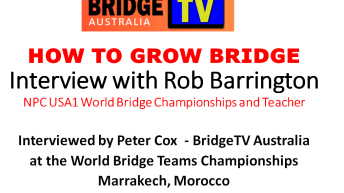A diamond pair in the world of bridge

They say diamonds are a girl’s best friend.
That proved to be the case for Sophie Ashton, though square-cut or pear-shaped jewels had nothing to do with it.
Ms Ashton held a handful of diamonds during a game of bridge, using the cards in a sly, strategic move against renowned player Sartaj Hans.
“I was so proud of myself because I knew how good a player Sartaj was,” she told AAP.
“His playing partner said to him quite crossly, ‘Do you trust the opposition? Or do you trust me?’
“There was all this tension at the table.”
Mr Hans remembers the moment too: “I suppose you could say she tricked me. And that sparked something.”
Nine years later, the couple is married and living in Goulburn, in the NSW southern tablelands, with their two young daughters.
The pair work at the Goulburn Health Hub, a service they developed to bring specialist medical care to the regional centre.
While they seem like ordinary professionals, they are big names in the bridge world in their spare time.
When Australia was dominating sports headlines across the British Open in golf, the Tour de France and the World Athletics Championships in July, Mr Hans and his teammates quietly triumphed too.
They beat the world number one US team, led by a bridge legend, Nick Nickell, in a 12-hour knockout event at the North American Bridge Championships in Rhode Island.
Mr Nickell’s team later took out the World Series in Poland in early September. The Australians ranked 16th out of about 100 teams.
“A team we beat went on to be world champions, so that gives us confidence,” Mr Hans said.
A talented chess player, Mr Hans was drawn to bridge while studying engineering at a university in India.
He and his classmates had to pass two of three exams, so they skipped one in favour of a card night.
“A friend taught us bridge and we played all night. We went to bed when the exam started,” Mr Hans recalls.
The friends played socially before he began taking it more seriously. In his early years, he remembers making risky “hero” plays to get recognition.
“That was a personal flaw. Gradually as I conquered that at bridge, it made an impact on my attitude to life as well.”
Ms Ashton cuts in with an affectionate joke, prompting a deep laugh from her husband: “Oh, he’s still a little bit arrogant”.
Having topped several high-level national tournaments, Ms Ashton describes bridge as an emotional, sophisticated mind game.
It involves strategy and an element of luck as players place bids and use code words while never showing their hand, even to a teammate.
“Bridge is a very heightened version of life,” Ms Ashton said.
“You have the highs, you have the lows, you have the partnership and the relationship and it’s how you deal with those.
“That’s helped me in life. When something bad happens, I’m much cooler, more calm and can be more practical than emotional.”
How a game imitates life was the central theme of the acclaimed Netflix show The Queen’s Gambit, which mixed the dizzying drama of professional chess with high fashion, romance and tragedy.
Bridge is searching for its own revamp. The Australian Bridge Federation wants to shake off the game’s old-fashioned stereotype and attract a new crowd.
Ms Ashton and Mr Hans have high hopes for the future of the game, which is increasingly played online.
“You get addicted to the rush. And because you’re sharing it with someone else or a team, it’s even better because you’re not alone in that feeling,” Ashton says.
“There’s never any end to your discovery of the game.”
Mr Hans adds: “It’s quite a journey.”




Add comment